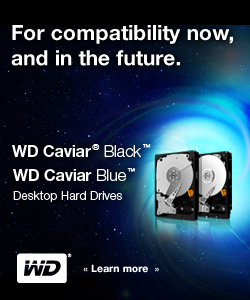The computer industry is characterized by increasing technology at a rapid rate. Moore’s law, for example, highlights the fast pace of innovation in the field of integrated circuitry. Rapid increases in storage capacities are also required of hard disk drives to meet market demand for storing the escalating amount of digital user data, including documents and collections of music, photos and video.
The ability for hard drives to maintain these storage capacity increases, through areal density growth, was first identified as a concern by an IBM Research Task-Force on April 20, 1998. IBM issued a report(1) identifying signal noise generated from the processing of magnetic bits as becoming a significant obstacle as areal density increases, resulting in greater Signal-to-Noise (SNR) losses. Overcoming these losses required methods to improve the error detection and correction capability (ECC) used in hard drives and required longer data sector sizes.
IBM demonstrated the concept that by increasing the sector block size from 512 bytes to 4,096 bytes (or “4K” blocks), the media space allocated to ECC algorithms could be maintained, while increasing the bit-error-rate (BER) correction capability by as much as three orders of magnitude, the equivalent of three decibels. The solution was proven effective in maintaining data integrity despite the impact from increased signal noise, called Signal-to-Noise Ratio (SNR) loss.
On August 26, 1998(2), the long data sector proposal was presented to the National Storage Industry Consortium (NSIC) on August 26, 1998. The hard drive industry’s ratification of the concept resulted in a white paper draft, which influenced the industry trade organization, International Disk Drive Equipment and Materials Association (IDEMA), to form the IDEMA Long Data Sector (LDS) Committee in 2000. IDEMA, in collaboration with industry-leading hardware and software suppliers, worked to define and develop the body of standards governing long data sectors(4). This effort included the methods by which compatibility with legacy computing components would be achieved.
In 2003, IBM, Maxtor Corporation (now Seagate Technologies), Seagate and Fujitsu (now Toshiba Storage Device Division) each submitted letters(5) to Microsoft Corporation, endorsing this new 4K block storage architecture, with the objective of gaining support for the technology in operating systems (OSs) designed and marketed by the company . Microsoft recognized the impact of long data sectors on storage capacity and agreed to design support for 4K block data processing in future OS releases.
The IDEMA Long Data Sector Committee also devised methods to provide downward compatibility with legacy systems using the traditional, 512 byte-per-sector architecture. The proposal for 512-byte emulation, or what is now known as AF 512e, was proposed by Seagate and Western Digital Corporation (WD). After standardization by the IDEMA LDS Committee in 2005, AF 512e was submitted to and accepted by Microsoft(5).
By 2008, the drive manufacturers (Fujitsu, Hitachi Global Storage Technologies, Samsung Electronics, Seagate, Toshiba and WD) had finalized plans to begin production of AF 512e products for mainstream usage by early 2011.
Ten years following the NSIC white paper, industry standards for the first official generation of long data sectors using the 4K sector configuration were completed,(6) and the transition to 4K was established as January 2011.(7) With 4K as its starting point, IDEMA continues its work with the hard drive industry to promote the definition, standardization and adoption of long data sector technologies and solutions. Specialized IDEMA LDS Committee work groups focus on the technical and marketing aspects concerning the sector format technologies that become standards under IDEMA’s guidance.
Through those efforts, Advanced Format (AF) has been designated as the moniker referring to data sector technologies beyond the legacy 512-byte format. IDEMA sponsored the creation of AF logos to easily distinguish long data sector-based hard disk drives from those using legacy 512 -byte sectors. The orange AF logo denotes legacy emulation solutions using long-data sector formats, while the blue AF (4Kn) logo signifies native implementations. These logos are expected to be represented on products, collateral and packaging for many generations of long-data sector technologies to come.
References:
- "IBM Task Force Findings." (p.5, “ECC-Capabilities, Overhead and Complexity”, M. Hassner, IBM Research, 4-20-1998)
https://idema.genweb.site/wp-content/plugins/download-monitor/download.php?id=1243 - "Large Data Block Size NSIC98." (Large Data Block Size, NSIC Discussion, D. Cheng, M. Hassner, P. Hodges, B. Lamberts, R.Wood, 8-27-1998)
https://idema.genweb.site/wp-content/plugins/download-monitor/download.php?id=1244 - "NSIC Large BLock Size White Paper." Draft. (P. Hodges, D. Cheng, 10-9-1998); http:/www.idema.org/wp-content/plugins/download-monitor/download.php?id=1248
- “About the Advanced Format Technology Committee (formerly LDS Committee)”. IDEMA; https://idema.genweb.site/?page_id=2012
- "HDD Long Data Sector White Paper". (IDEMA Hard Disk Drive Long Data Sector White Paper 4-20-2007)
http:/www.idema.org/wp-content/plugins/download-monitor/download.php?id=1222 - "4K HDD Committee Accomplishment." (May 3rd, 2010)
https://idema.genweb.site/wp-content/plugins/download-monitor/download.php?id=1218 - "Are You Ready? Press Release." (IDEMA Press Release, June 29th, 2010)
https://idema.genweb.site/wp-content/plugins/download-monitor/download.php?id=1219


